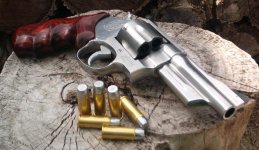The 624's a known/famous for their .432" throats. Until I used .432"/.4325" lead/cast/swaged bullets accuracy wasn't there. If you have a 624 with cylinders throats less than .432" diameter, your cylinder has more than most likely been replaced.
I've owned several of them over the decades and every 1 of them had .432" cylinder throats.
I've used cast/lead bullets in revolvers with as much as 3/1000th's difference between the cylinder throats and the bbl. Accuracy really started to fall off if I went any larger.
I finely sold that 624 pictured above. Had 4 different firearms chambered in the 44cal's. Got tired of having a "special" bullet or a 624 only bullet when .430" bullets worked in the other 3 firearms.
The 624 cylinders are not only over sized they are over sized a looooooong way (I'm not yelling at anyone with the loooong thing). That's why they had a recall and tested every 624 to see if a 44mag round would fit into the cylinders of the 624. Hence the red "S"in the circle stamped on the s&w blue box.
I even tried hollow based bullets, namely hbwc's from a custom mold, keith hb swc's from a lyman 429422 mold and hb fn from a raphine mold. The 624 cylinders were too long/big for those hb bullets to expand/seal the cylinders unless the bullets were sized to .431"/.432".
That is why the statement, look at the picture of the 624 I posted above and you can see that the .432" hbwc's would fit the 624's cylinder with them sticking 1/2" above the case.
I've owned several of them over the decades and every 1 of them had .432" cylinder throats.
I've used cast/lead bullets in revolvers with as much as 3/1000th's difference between the cylinder throats and the bbl. Accuracy really started to fall off if I went any larger.
I finely sold that 624 pictured above. Had 4 different firearms chambered in the 44cal's. Got tired of having a "special" bullet or a 624 only bullet when .430" bullets worked in the other 3 firearms.
The 624 cylinders are not only over sized they are over sized a looooooong way (I'm not yelling at anyone with the loooong thing). That's why they had a recall and tested every 624 to see if a 44mag round would fit into the cylinders of the 624. Hence the red "S"in the circle stamped on the s&w blue box.
I even tried hollow based bullets, namely hbwc's from a custom mold, keith hb swc's from a lyman 429422 mold and hb fn from a raphine mold. The 624 cylinders were too long/big for those hb bullets to expand/seal the cylinders unless the bullets were sized to .431"/.432".
That is why the statement, look at the picture of the 624 I posted above and you can see that the .432" hbwc's would fit the 624's cylinder with them sticking 1/2" above the case.

